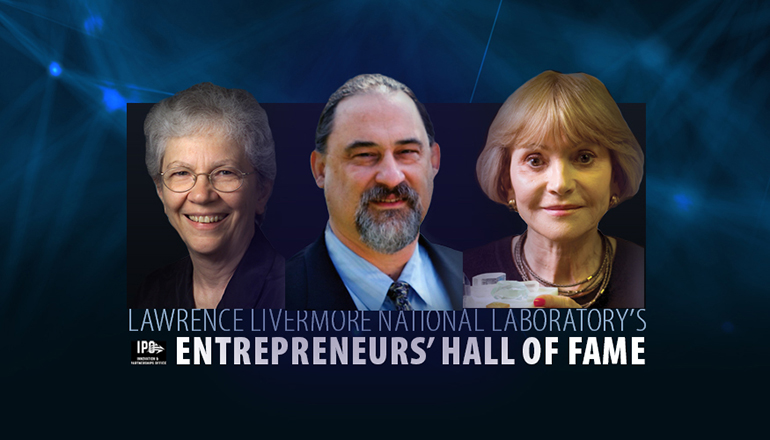
One current and two former Lawrence Livermore National Laboratory scientists have been inducted into the Laboratory’s Entrepreneurs’ Hall of Fame. From left: Mary Spaeth, Tony Ruggiero and Natalia Zaitseva.
One current and two former Lawrence Livermore National Laboratory (LLNL) scientists have been inducted into the Laboratory’s Entrepreneurs’ Hall of Fame (EHF).
The trio, who represent the third class of inductees into the Lab’s EHF, have been honored for developing technologies during or after their Lab careers that created major economic impacts or spawned new companies.
“The story of the Lab’s contributions to U.S. economic competitiveness is told through the careers and accomplishments of these three individuals and our initial two classes of 19 inductees,” said Roger Werne, a senior adviser in the Lab’s Innovation and Partnerships Office and founder of the EHF.
“The bottom line is that by researching the careers of these scientists and engineers, we have uncovered the untold story of LLNL’s contributions to the U.S. economy,” said Werne.
The first class of 15 former Lab scientists and engineers who were installed in the EHF were honored in 2012 as part of the Laboratory’s 60th anniversary celebration.
Together, those 15 researchers started 23 companies and developed about 50 products. Software developed by one of those engineers, John Hallquist, enabled computerized automobile crash simulation, which currently saves that industry about $14 billion a year in cost avoidance.
The second class of four inductees was installed in 2015. Between them, they initially started three different companies – an internet security firm, a biomedical company that advanced personalized medicine, and a microchip firm.
Here are this year’s three inductees.
Using lasers to transmit data
Tony Ruggiero joined the LLNL Physics directorate in 1990 and his career evolved over the next 18 years, highlighted by significant research and development advances in ultrahigh bandwidth laser optical free-space communications.
The technology transmitted data at 2.5 Gb/sec on a single laser channel, a rate comparable to 400 channels of television or 40,000 simultaneous phone calls.
In March 2009, his work in photonics, laser technologies and optoelectronics led him to start what would become a highly successful entrepreneurial venture known as Sierra Photonics.
The company became so successful in producing exceptional technologies that it caught the eye of Google. Ruggiero guided the company through a smooth acquisition by Google X.
Ruggiero, who passed away in March 2018, received his bachelor’s degree from the University of Arizona in Tucson and his Ph.D. in physical chemistry from the University of Oregon.
“Tony will be remembered at LLNL, not only for his work ethic and personability, but for his appreciation for the support of those around him who contributed to his great successes at the Lab and as an entrepreneur,” said Werne.
Ensuring NIF requirements met
Laser physicist Mary Spaeth joined the LLNL Laser Program in 1974, attracted to Livermore by the opportunity to use tunable dye lasers to produce enriched uranium, a technology later transferred to the U.S. Enrichment Corporation for further commercial development.
Later, she became chief technologist for the National Ignition Facility (NIF), the world’s most energetic laser. Building NIF required breakthroughs in laser and optical element manufacturing at scales more than 100x previously available, with unprecedented precision and accuracy.
As the lead systems engineer, Spaeth played a key role in ensuring that the requirements, quality, acceptance, installation, and commissioning processes for more than $1.2 billion of equipment went flawlessly.
Spaeth received her Bachelor of Science degree in physics and mathematics from Valparaiso University in Indiana in 1960 and her Master of Science in physics from Wayne State University in 1962.
Spaeth began her career at Hughes Aircraft Company in Culver City. She rapidly became known as an innovator in laser physics, optical design and device engineering, as well as one of the original innovators in tunable dye lasers, which revolutionized the laser industry.
Developing new materials for fusion and homeland security
Materials scientist Natalia Zaitseva joined LLNL in 1993 to lead the development of rapid growth technology for large potassium dihydrogen phosphate (KDP) and potassium dideuterium phosphate (DKDP) crystals for NIF, a technology that proved critical for the laser’s eventual success.
With traditional growth methods, it would have required 2-3 years to grow the 55-cm-size KDP crystals needed for the Livermore laser.
Zaitseva’s new technology increased the growth rate for the KDP crystals from the traditional method’s rate of about 1 mm per day to 10 to 20 mm per day, allowing the growth time for crystals to be cut to 1 to 1 ½ months.
Cleveland Crystals Inc. partnered with LLNL in the 1990s to commercialize Zaitseva’s new technology, providing KDP crystals to NIF.
Following her rapid crystal growth research, Zaitseva applied her skills to a radiation detection problem for the U.S. Department of Homeland Security.
The agency was seeking technology to better detect the illicit smuggling of nuclear materials that might be used in the creation of weapons of mass destruction. She developed stilbene crystals for detecting neutrons from these materials, a technology commercialized by Inrad Optics.
In addition, in 2012 Zaitseva led a team of LLNL researchers in developing the first plastic material capable of efficiently distinguishing neutrons from gamma rays, something not thought possible for the previous five decades.
The new technology could assist in detecting nuclear substances such as plutonium and uranium that might be used in improvised nuclear devices by terrorists and could help in detecting neutrons in major scientific projects. The technology has been commercialized by a Texas company.
Zaitseva received her Master of Science degree in physical chemistry from the Mendeleev Institute of Chemical Technology in 1971 and her Ph.D. in physics and mathematics from Moscow State University in 1989, both in Moscow, Russia.
For more information, click here.





Tell Us What You Think!